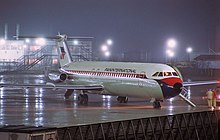Paninternational Flight 112
 D-ALAR, the BAC One-Eleven involved, seen nine months before the accident | |
| Accident | |
|---|---|
| Date | 6 September 1971 |
| Summary | Dual engine failure due to overheating after accidentally filling the water injection mechanism with jet fuel |
| Site | Bundesautobahn 7 53°42′10″N 09°56′33″E / 53.70278°N 9.94250°E |
| Aircraft | |
| Aircraft type | BAC One-Eleven |
| Operator | Paninternational |
| Registration | D-ALAR |
| Flight origin | Hamburg Airport, Hamburg, Germany |
| Destination | Málaga Airport, Málaga, Spain |
| Occupants | 121 |
| Passengers | 115 |
| Crew | 6 |
| Fatalities | 22 |
| Injuries | 99 |
| Survivors | 99 |
Paninternational Flight 112 was a BAC One-Eleven operated by German airline Paninternational that crashed in Hasloh on 6 September 1971 while attempting to land on an autobahn following the failure of both engines. The accident killed 22 passengers and crew out of 121 on board.
Aircraft
The aircraft, registered as D-ALAR, had its first flight the year before the accident.[1]
Accident
Paninternational Flight 112 took off from Hamburg Airport in Hamburg, Germany, on a flight to Málaga Airport in Málaga, Spain, with 115 passengers and six crew on board.[1] After the take-off, both engines failed and the pilots decided to make an emergency landing on a highway – Bundesautobahn 7 (also part of European route E45)[2] – about 4.5 km (3 mi; 2 nmi) from Hamburg Airport.[1] During the landing the aircraft collided with a bridge, causing both wings to shear off; subsequently catching fire.[1] The accident killed twenty-one passengers and one crew member.[1]
Cause of the crash
Subsequent investigation showed that the tank for the water-injection engine thrust-augmentation system (used during take-off) had inadvertently been filled with jet fuel instead of water. Spraying this additional jet fuel into the engines during take-off significantly increased the engine rpm and quickly caused both engines to overheat and fail, resulting in the crash.
References
- ^ a b c d e Ranter, Harro. "ASN Aircraft accident BAC One-Eleven 515FB D-ALAR Hamburg-Fuhlsbüttel Airport (HAM)". aviation-safety.net. Aviation Safety Network.
{{cite web}}: CS1 maint: url-status (link) - ^ "Autobahnatlas.de information for A7". www.autobahnatlas-online.de (in German). Retrieved 29 May 2010.
{{cite web}}: CS1 maint: url-status (link)
